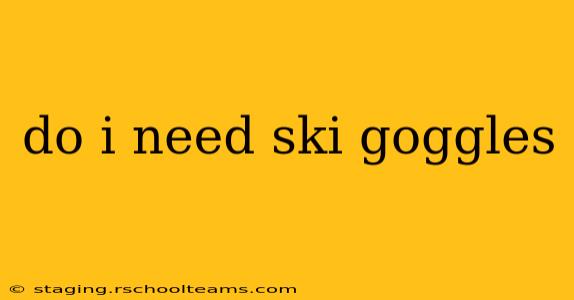Do I Need Ski Goggles? A Comprehensive Guide to Eye Protection on the Slopes
Skiing and snowboarding are exhilarating winter sports, but they also present significant risks, especially to your eyes. The question of whether you need ski goggles is a resounding yes, and here's why. While sunglasses might seem sufficient for a sunny day, they simply don't offer the crucial protection ski goggles provide.
What are the dangers to my eyes while skiing or snowboarding?
Your eyes are vulnerable to a range of hazards on the slopes. These include:
- High-speed impacts: Debris like ice, snow, and even small twigs can be flung up at high speeds, potentially causing serious eye injuries.
- UV radiation: High-altitude sun reflects strongly off the snow, leading to increased exposure to harmful ultraviolet (UV) rays. Prolonged exposure can cause snow blindness (photokeratitis), a painful and temporary condition.
- Wind and cold: The wind chill on a snowy mountain can dry out your eyes, making them susceptible to irritation and discomfort.
- Bright sunlight: The intense sunlight reflected off the snow can be blinding, impairing your vision and increasing the risk of accidents.
What makes ski goggles superior to sunglasses?
Ski goggles provide a level of protection far beyond what sunglasses offer. Key differences include:
- Complete coverage: Goggles completely shield your eyes and the surrounding area from flying debris. Sunglasses, on the other hand, leave the sides of your eyes vulnerable.
- Impact resistance: High-quality ski goggles are made from impact-resistant materials, significantly reducing the risk of eye injury from collisions.
- UV protection: Good ski goggles offer 100% UV protection, shielding your eyes from the sun's harmful rays at high altitudes.
- Enhanced clarity: Many ski goggles feature specialized lenses designed to enhance contrast and visibility in various snow conditions, improving your overall performance and safety.
- Fog prevention: Many modern goggles incorporate anti-fog coatings or ventilation systems to prevent fogging, ensuring clear vision even during strenuous activity.
What features should I look for in ski goggles?
Choosing the right ski goggles depends on your individual needs and preferences. Consider these features:
- Lens type: Different lens tints are optimized for various light conditions. Look for goggles with interchangeable lenses to adapt to changing weather.
- Fit: Ensure a snug, comfortable fit to prevent gaps and maximize protection.
- Ventilation: Adequate ventilation helps prevent fogging.
- Impact resistance: Choose goggles made from durable, impact-resistant materials.
- UV protection: Confirm that the goggles offer 100% UV protection.
Can I wear prescription glasses under my ski goggles?
While it's possible, it's not ideal. Wearing glasses under goggles can restrict airflow, increasing the chance of fogging. Consider getting goggles with prescription lenses inserted or using contact lenses for optimal comfort and vision.
Are ski goggles only necessary for experienced skiers?
No! Regardless of your skill level, everyone skiing or snowboarding should wear goggles. Beginners are often more likely to fall, increasing their risk of eye injury from flying debris or contact with the snow.
What are the consequences of not wearing ski goggles?
Skiing or snowboarding without goggles significantly increases your risk of:
- Eye injuries: Scratches, abrasions, and even more serious injuries like corneal damage.
- Snow blindness: A painful condition causing temporary vision impairment.
- Eye irritation: Dryness, discomfort, and inflammation from wind and cold.
In conclusion, wearing ski goggles is not a luxury but a necessity for protecting your eyes on the slopes. The potential consequences of not wearing them far outweigh any perceived inconvenience. Prioritize your eye health and safety by investing in a quality pair of goggles designed to meet the demands of the slopes.
